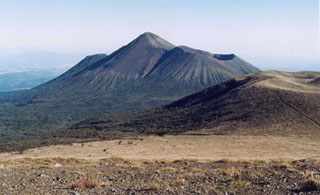Report on Kirishimayama (Japan) — September 1978
Scientific Event Alert Network Bulletin, vol. 3, no. 9 (September 1978)
Managing Editor: David Squires.
Kirishimayama (Japan) Earthquake swarm 7 July
Please cite this report as:
Global Volcanism Program, 1978. Report on Kirishimayama (Japan) (Squires, D., ed.). Scientific Event Alert Network Bulletin, 3:9. Smithsonian Institution. https://doi.org/10.5479/si.GVP.SEAN197809-282090
Kirishimayama
Japan
31.934°N, 130.862°E; summit elev. 1700 m
All times are local (unless otherwise noted)
An earthquake swarm in the vicinity of Kirishima, including some felt events, was recorded on 7 July. No surface activity was observed. Kirishima's last eruption, on 5 August 1971, ejected accessory tephra and mud. No seismicity was recorded preceding the 1971 eruption.
Further Reference. Ida, Y., Yamaguchi, M, and Masutani, F., 1986, Recent seismicity and stress field in Kirishima volcano: Journal of the Seismological Society of Japan, v. 39, p. 111-121.
Geological Summary. Kirishimayama is a large group of more than 20 Quaternary volcanoes located north of Kagoshima Bay. The late-Pleistocene to Holocene dominantly andesitic group consists of stratovolcanoes, pyroclastic cones, maars, and underlying shield volcanoes located over an area of 20 x 30 km. The larger stratovolcanoes are scattered throughout the field, with the centrally located Karakunidake being the highest. Onamiike and Miike, the two largest maars, are located SW of Karakunidake and at its far eastern end, respectively. Holocene eruptions have been concentrated along an E-W line of vents from Miike to Ohachi, and at Shinmoedake to the NE. Frequent small-to-moderate explosive eruptions have been recorded since the 8th century.
Information Contacts: Japan Meteorological Agency (JMA); D. Shackelford, CA.

